Ortiz de Montellano Paul R.(Ed.) Cytochrome P450. Structure, Mechanism, and Biochemistry
Подождите немного. Документ загружается.

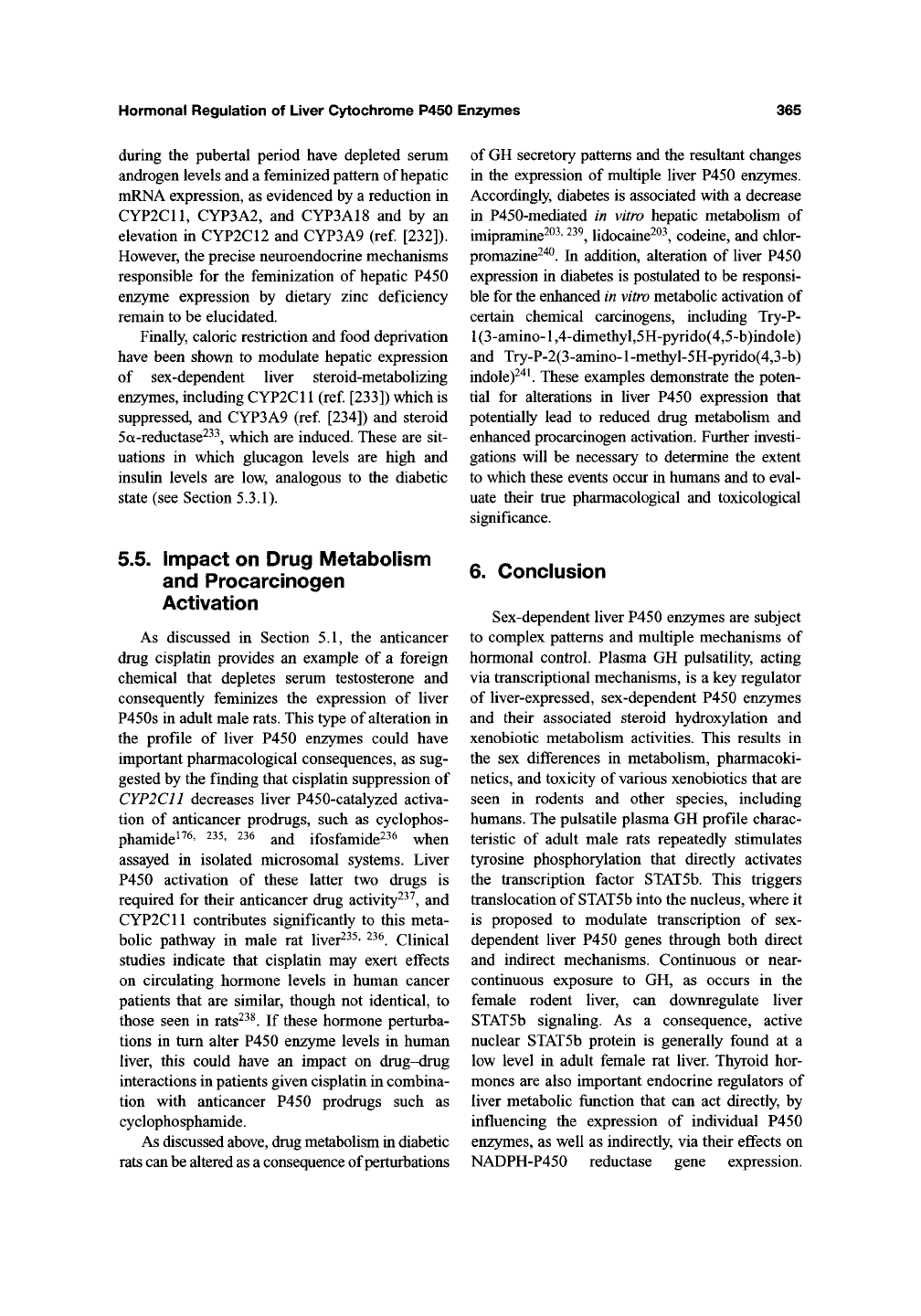
Hormonal Regulation of Liver Cytochrome P450 Enzymes
365
during the pubertal period have depleted serum
androgen levels and a feminized pattern of hepatic
mRNA expression, as evidenced by a reduction in
CYP2C11,
CYP3A2, and CYP3A18 and by an
elevation in CYP2C12 and CYP3A9 (ref [232]).
However, the precise neuroendocrine mechanisms
responsible for the feminization of hepatic P450
enzyme expression by dietary zinc deficiency
remain to be elucidated.
Finally, caloric restriction and food deprivation
have been shown to modulate hepatic expression
of sex-dependent liver steroid-metabolizing
enzymes, including CYP2C11 (ref [233]) which is
suppressed, and CYP3A9 (ref [234]) and steroid
5a-reductase^^^, which are induced. These are sit-
uations in which glucagon levels are high and
insulin levels are low, analogous to the diabetic
state (see Section 5.3.1).
5.5. Impact on Drug Metabolism
and Procarcinogen
Activation
As discussed in Section 5.1, the anticancer
drug cisplatin provides an example of a foreign
chemical that depletes serum testosterone and
consequently feminizes the expression of liver
P450s in adult male rats. This type of alteration in
the profile of liver P450 enzymes could have
important pharmacological consequences, as sug-
gested by the finding that cisplatin suppression of
CYP2C11 decreases liver P450-catalyzed activa-
tion of anticancer prodrugs, such as cyclophos-
phamide^^^' ^^^' ^^^ and ifosfamide^^^ when
assayed in isolated microsomal systems. Liver
P450 activation of these latter two drugs is
required for their anticancer drug activity^^^, and
CYP2C11 contributes significantly to this meta-
bolic pathway in male rat liver^^^' ^^^. Clinical
studies indicate that cisplatin may exert effects
on circulating hormone levels in human cancer
patients that are similar, though not identical, to
those seen in rats^^^. If these hormone perturba-
tions in turn alter P450 enzyme levels in human
liver, this could have an impact on drug-drug
interactions in patients given cisplatin in combina-
tion with anticancer P450 prodrugs such as
cyclophosphamide.
As discussed
above,
drug metabolism in diabetic
rats can
be
altered as a consequence of perturbations
of GH secretory patterns and the resultant changes
in the expression of multiple liver P450 enzymes.
Accordingly, diabetes is associated with a decrease
in P450-mediated in vitro hepatic metabolism of
imipramine^^^'
^^^,
lidocaine^^^, codeine, and chlor-
promazine^^^. In addition, alteration of liver P450
expression in diabetes is postulated to be responsi-
ble for the enhanced in
vitro
metabolic activation of
certain chemical carcinogens, including Try-P-
1 (3-amino-1,4-dimethyl,5H-pyrido(4,5-b)indole)
and Try-P-2(3-amino-1 -methyl-5H-pyrido(4,3-b)
indole)^'*^ These examples demonstrate the poten-
tial for alterations in liver P450 expression that
potentially lead to reduced drug metabolism and
enhanced procarcinogen activation. Further investi-
gations will be necessary to determine the extent
to which these events occur in humans and to eval-
uate their true pharmacological and toxicological
significance.
6. Conclusion
Sex-dependent liver P450 enzymes are subject
to complex patterns and multiple mechanisms of
hormonal control. Plasma GH pulsatility, acting
via transcriptional mechanisms, is a key regulator
of liver-expressed, sex-dependent P450 enzymes
and their associated steroid hydroxylation and
xenobiotic metabolism activities. This results in
the sex differences in metabolism, pharmacoki-
netics,
and toxicity of various xenobiotics that are
seen in rodents and other species, including
humans. The pulsatile plasma GH profile charac-
teristic of adult male rats repeatedly stimulates
tyrosine phosphorylation that directly activates
the transcription factor STAT5b. This triggers
translocation of
STAT5b
into the nucleus, where it
is proposed to modulate transcription of sex-
dependent liver P450 genes through both direct
and indirect mechanisms. Continuous or near-
continuous exposure to GH, as occurs in the
female rodent liver, can downregulate liver
STAT5b signaling. As a consequence, active
nuclear STAT5b protein is generally found at a
low level in adult female rat liver. Thyroid hor-
mones are also important endocrine regulators of
liver metabolic function that can act directly, by
influencing the expression of individual P450
enzymes, as well as indirectly, via their effects on
NADPH-P450 reductase gene expression.

David J. Waxman and Thomas K.H. Chang
Gonadal hormones also play a role, but their
effects on liver P450 activity are largely indirect
and are mediated by the hypothalamic-pituitary
axis and its control of plasma GH levels. Sex
dif-
ferences in GH secretory dynamics also occur in
humans and can be modulated by gonadal hor-
mones. This sexually dimorphic GH secretion
may contribute to the apparent sex differences in
the levels of certain human P450s and in human
P450-catalyzed drug metabolism and pharmaco-
kinetics. Finally, diverse factors, including many
drugs and other xenochemicals, pathophysiologi-
cal state, and dietary factors can affect hormone
secretion and the hepatic expression of sex-
dependent P450s, which in turn may impact drug
metabolism and procarcinogen activation.
Acknowledgment
Studies carried out in the laboratory of DJW
were supported in part by the National Institutes
of Health (Grant DK33765).
References
1.
Kato,
R.
(1974). Sex-related differences
in
drug
metabolism. Drug
Metab.
Rev.
3, 1-32.
2.
Kato, R. (1977). Drug metabolism under pathological
and abnormal physiological states
in
animals
and
man. Xenobiotica
7,
25-92.
3.
Skett, P. (1987). Hormonal regulation
and sex
differ-
ences
of
xenobiotic metabolism. Prog. Drug. Metab.
10,
85-139.
4.
Davies,
D.S., PL.
Gigon,
and J.R.
Gillette (1969).
Species and sex differences
in
electron transport sys-
tems
in
liver microsomes
and
their relationship
to
ethylmorphine demethylation. Life Sci.
8,
85-91.
5.
Gurtoo,
H.L. and
N.B. Parker (1976). Organ speci-
ficity
of
the
sex
dependent regulation
of
aryl hydro-
carbon hydroxylase (AHH)
in
rat. Biochem. Biophys.
Res.
Commun. 11, 216-222.
6. Kato,
R. and
J.R. Gillette (1965).
Sex
differences
in
the effects
of
abnormal physiological states
on the
metabolism
of
drugs
by rat
liver microsomes.
J.
Pharmacol. Exp. Ther. 150,
285-291.
7.
Guengerich,
F.P.
(1987). Enzymology
of rat
liver
cytochromes P450.
In F.P.
Guengerich (ed.),
Mammalian Cytochromes P450, Vol.
1. CRC
Press,
Boca Raton, FL, pp.
1-54.
8. Ryan,
D.E. and
W. Levin (1990). Purification
and
characterization
of
hepatic microsomal cytochrome
P-450. Pharmacol. Ther. 45, 153-239.
9. Nelson,
D.R.
(2003). Comparison
of
P450s from
human
and
fugu:
420
million years
of
vertebrate
P450 evolution.
Arch.
Biochem. Biophys. 409,18-24.
10.
Nelson,
D.R., L.
Koymans,
T.
Kamataki,
J.J. Stegeman,
R.
Feyereisen,
D.J.
Waxman
et al.
(1996).
P450 superfamily: Update
on new
sequences, gene mapping, accession numbers
and
nomenclature. Pharmacogenetics
6, 1-42.
11.
Waxman,
D.J.
(1988). Interactions
of
hepatic
cytochromes P-450 with steroid hormones.
Regioselectivity
and
stereospecificity
of
steroid
metabolism
and
hormonal regulation
of rat
P-450
enzyme expression. Biochem. Pharmacol.
37,
71-84.
12.
Beierle,
I., B.
Meibohm,
and H.
Derendorf (1999).
Gender differences
in
pharmacokinetics
and
phar-
macodynamics.
Int. J.
Clin. Pharmacol. Ther.
37,
529-547.
13.
Schwartz, J.B. (2003). The influence
of
sex
on phar-
macokinetics. Clin. Pharmacokinet. 42,
107-121.
14.
Tanaka,
E.
(1999). Gender-related differences
in
pharmacokinetics
and
their clinical significance.
J.
Clin. Pharm. Ther. 24, 339-346.
15.
Harris, R.Z., L.Z. Benet,
and
J.B. Schwartz (1995).
Gender effects
in
pharmacokinetics
and
pharmaco-
dynamics. Drugs 50, 222-239.
16.
Meibohm,
B., I.
Beierle,
and H.
Derendorf (2002).
How important are gender differences
in
pharmaco-
kinetics? Clin. Pharmacokinet. 41, 329-342.
17.
Hunt,
CM., WR.
Westerkam,
and G.M.
Stave
(1992).
Effect
of
age
and
gender
on the
activity
of
human hepatic CYP3A. Biochem. Pharmacol.
44,
275-283.
18.
Zaphiropoulos,
PG,, A.
Mode,
G.
Norstedt,
and
J. A. Gustafsson (1989). Regulation
of
sexual differ-
entiation
in
drug
and
steroid metabolism. Trends
Pharmacol. Sci.
10,
149-153.
19.
Waxman, D.J. (1984). Rat hepatic cytochrome P-450
isoenzyme
2c.
Identification
as a
male-specific,
developmentally induced steroid
16
alpha-hydroxy-
lase and comparison to
a
female-specific cytochrome
P-450 isoenzyme.
J.
Biol. Chem. 259, 15481-15490.
20.
Morgan,
E.T., C.
MacGeoch,
and
J.-A. Gustafsson
(1985).
Hormonal
and
developmental regulation
of expression
of the
hepatic microsomal steroid
16alpha-hydroxylase cytochrome P-450 apoprotein
in the rat. J. Biol. Chem. 260, 11895-11898.
21.
Waxman,
D.J., G.A.
Dannan,
and F.P
Guengerich
(1985).
Regulation of rat hepatic cytochrome P-450:
Age-dependent expression, hormonal imprinting,
and xenobiotic inducibility
of
sex-specific isoen-
zymes. Biochemistry 24, 4409-4417.
22.
MacGeoch,
C, E.T.
Morgan,
and J.A.
Gustafsson
(1985).
Hypothalamo-pituitary regulation
of
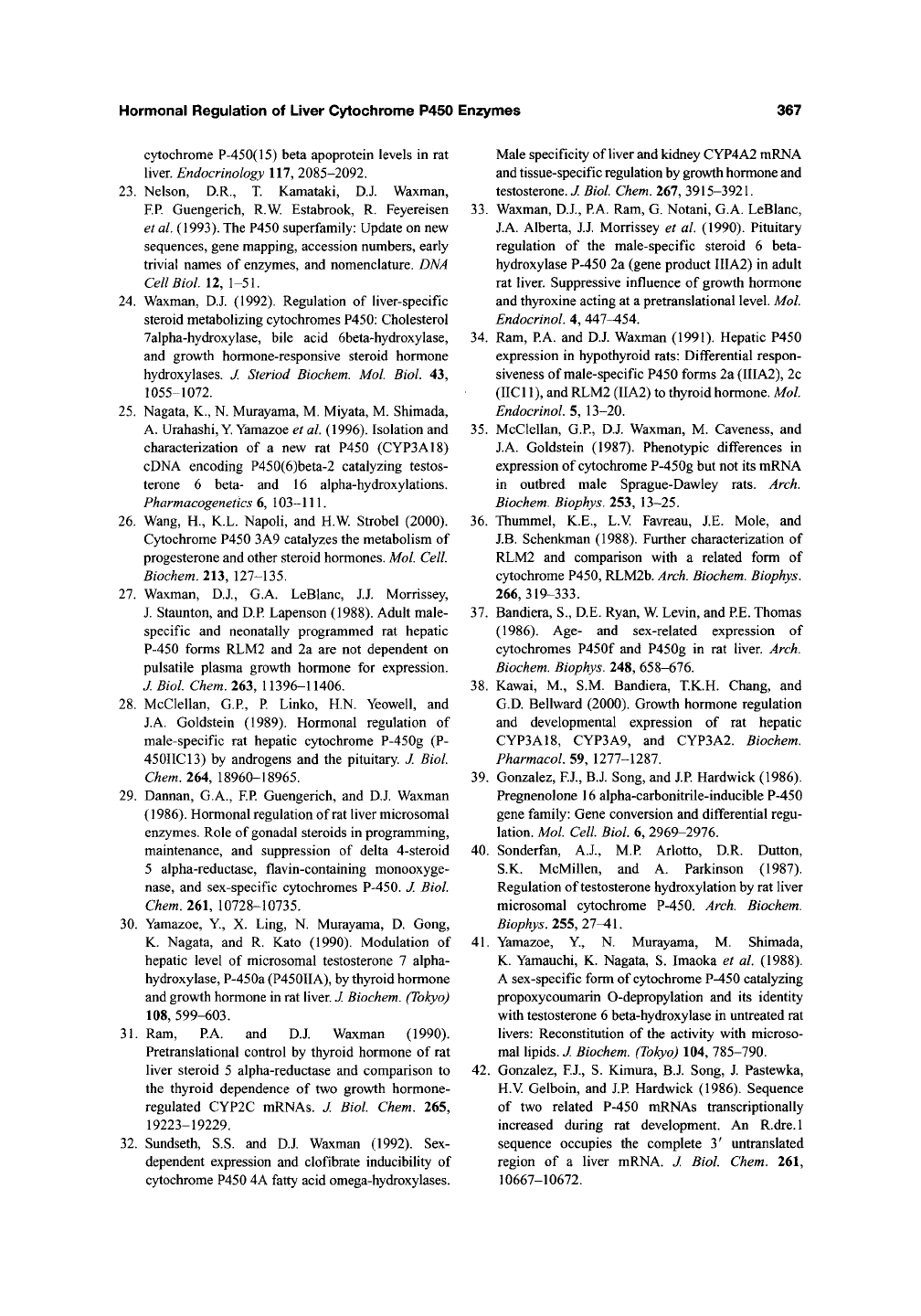
Hormonal Regulation of Liver Cytochrome P450 Enzymes
367
cytochrome P-450(15) beta apoprotein levels in rat
liver. Endocrinology 111, 2085-2092.
23.
Nelson, D.R., T. Kamataki, D.J. Waxman,
F.P.
Guengerich, R.W. Estabrook, R. Feyereisen
et
al.
(1993). The P450 superfamily: Update on new
sequences, gene mapping, accession numbers, early
trivial names of enzymes, and nomenclature. DMA
Cell Biol 12, 1-51.
24.
Waxman, D.J. (1992). Regulation of liver-specific
steroid metabolizing cytochromes P450: Cholesterol
Talpha-hydroxylase, bile acid 6beta-hydroxylase,
and growth hormone-responsive steroid hormone
hydroxylases. J. Steriod Biochem. Mol Biol. 43,
1055-1072.
25.
Nagata, K., N. Murayama, M. Miyata, M. Shimada,
A. Urahashi,
Y.
Yamazoe et al. (1996). Isolation and
characterization of a new rat P450 (CYP3A18)
cDNA encoding P450(6)beta-2 catalyzing testos-
terone 6 beta- and 16 alpha-hydroxylations.
Pharmacogenetics 6,
103-111.
26.
Wang, H., K.L. Napoh, and H.W. Strobel (2000).
Cytochrome P450 3A9 catalyzes the metabolism of
progesterone and other steroid hormones. Mol. Cell.
Biochem. 213, 127-135.
27.
Waxman, D.J., G.A. LeBlanc, J.J. Morrissey,
J. Staunton, and D.P. Lapenson (1988). Adult male-
specific and neonatally programmed rat hepatic
P-450 forms RLM2 and 2a are not dependent on
pulsatile plasma growth hormone for expression.
J. Biol. Chem. 263, 11396-11406.
28.
McClellan, G.P, P Linko, H.N. Yeowell, and
J.A. Goldstein (1989). Hormonal regulation of
male-specific rat hepatic cytochrome P-450g (P-
450IIC13) by androgens and the pituitary. J. Biol.
Chem.
264, 18960-18965.
29.
Dannan, G.A., F.P. Guengerich, and D.J. Waxman
(1986).
Hormonal regulation of rat liver microsomal
enzymes. Role of gonadal steroids in programming,
maintenance, and suppression of delta 4-steroid
5 alpha-reductase, flavin-containing monooxyge-
nase,
and sex-specific cytochromes P-450. J. Biol.
Chem.
261, 10728-10735.
30.
Yamazoe, Y, X. Ling, N. Murayama, D. Gong,
K. Nagata, and R. Kato (1990). Modulation of
hepatic level of microsomal testosterone 7 alpha-
hydroxylase, P-450a (P450IIA), by thyroid hormone
and growth hormone in rat liver.
J.
Biochem. (Tokyo)
108,
599-603.
31.
Ram, PA. and D.J. Waxman (1990).
Pretranslational control by thyroid hormone of rat
liver steroid 5 alpha-reductase and comparison to
the thyroid dependence of two growth hormone-
regulated CYP2C mRNAs. J. Biol. Chem. 265,
19223-19229.
32.
Sundseth, S.S. and D.J. Waxman (1992). Sex-
dependent expression and clofibrate inducibility of
cytochrome P450 4A fatty acid omega-hydroxylases.
Male specificity of liver and kidney CYP4A2 mRNA
and tissue-specific regulation by growth hormone and
testosterone. J. Biol. Chem. 267, 3915-3921.
33.
Waxman, D.J., PA. Ram, G. Notani, G.A. LeBlanc,
J.A. Alberta, J.J. Morrissey et al. (1990). Pituitary
regulation of the male-specific steroid 6 beta-
hydroxylase P-450 2a (gene product IIIA2) in adult
rat liver. Suppressive influence of growth hormone
and thyroxine acting at a pretranslational level. Mol.
Endocrinol. 4, 447^54.
34.
Ram, PA. and D.J. Waxman (1991). Hepatic P450
expression in hypothyroid rats: Differential respon-
siveness of male-specific P450 forms 2a (IIIA2), 2c
(IICl
1),
and RLM2 (IIA2) to thyroid hormone. Mol.
Endocrinol. 5, 13-20.
35.
McClellan, G.P, D.J. Waxman, M. Caveness, and
J.A. Goldstein (1987). Phenotypic differences in
expression of cytochrome P-450g but not its mRNA
in outbred male Sprague-Dawley rats. Arch.
Biochem. Biophys. 253, 13-25.
36.
Thummel, K.E., L.V Favreau, J.E. Mole, and
J.B.
Schenkman (1988). Further characterization of
RLM2 and comparison with a related form of
cytochrome P450, RLM2b. Arch. Biochem. Biophys.
266,319-333.
37.
Bandiera, S., D.E. Ryan,
W.
Levin, and PE. Thomas
(1986).
Age- and sex-related expression of
cytochromes P450f and P450g in rat liver. Arch.
Biochem. Biophys. 248, 658-676.
38.
Kawai, M., S.M. Bandiera, T.K.H. Chang, and
G.D. Bellward (2000). Growth hormone regulation
and developmental expression of rat hepatic
CYP3A18, CYP3A9, and CYP3A2. Biochem.
Pharmacol. 59, 1277-1287.
39.
Gonzalez, EJ., B.J. Song, and J.P Hardwick (1986).
Pregnenolone 16 alpha-carbonitrile-inducible P-450
gene family: Gene conversion and differential regu-
lation. Mol. Cell Biol 6, 2969-2976.
40.
Sonderfan, A.J., M.P Arlotto, D.R. Dutton,
S.K. McMillen, and A. Parkinson (1987).
Regulation of testosterone hydroxylation by rat liver
microsomal cytochrome P-450. Arch. Biochem.
Biophys. 255, 21^1.
41.
Yamazoe, Y, N. Murayama, M. Shimada,
K. Yamauchi, K. Nagata, S. Imaoka et al (1988).
A sex-specific form of cytochrome P-450 catalyzing
propoxycoumarin 0-depropylation and its identity
with testosterone 6 beta-hydroxylase in untreated rat
livers:
Reconstitution of the activity with microso-
mal lipids. J. Biochem. (Tokyo) 104, 785-790.
42.
Gonzalez, F.J., S. Kimura, B.J. Song, J. Pastewka,
H.V Gelboin, and J.P Hardwick (1986). Sequence
of two related P-450 mRNAs transcriptionally
increased during rat development. An R.dre.l
sequence occupies the complete 3' untranslated
region of a liver mRNA, J. Biol. Chem. 261,
10667-10672.
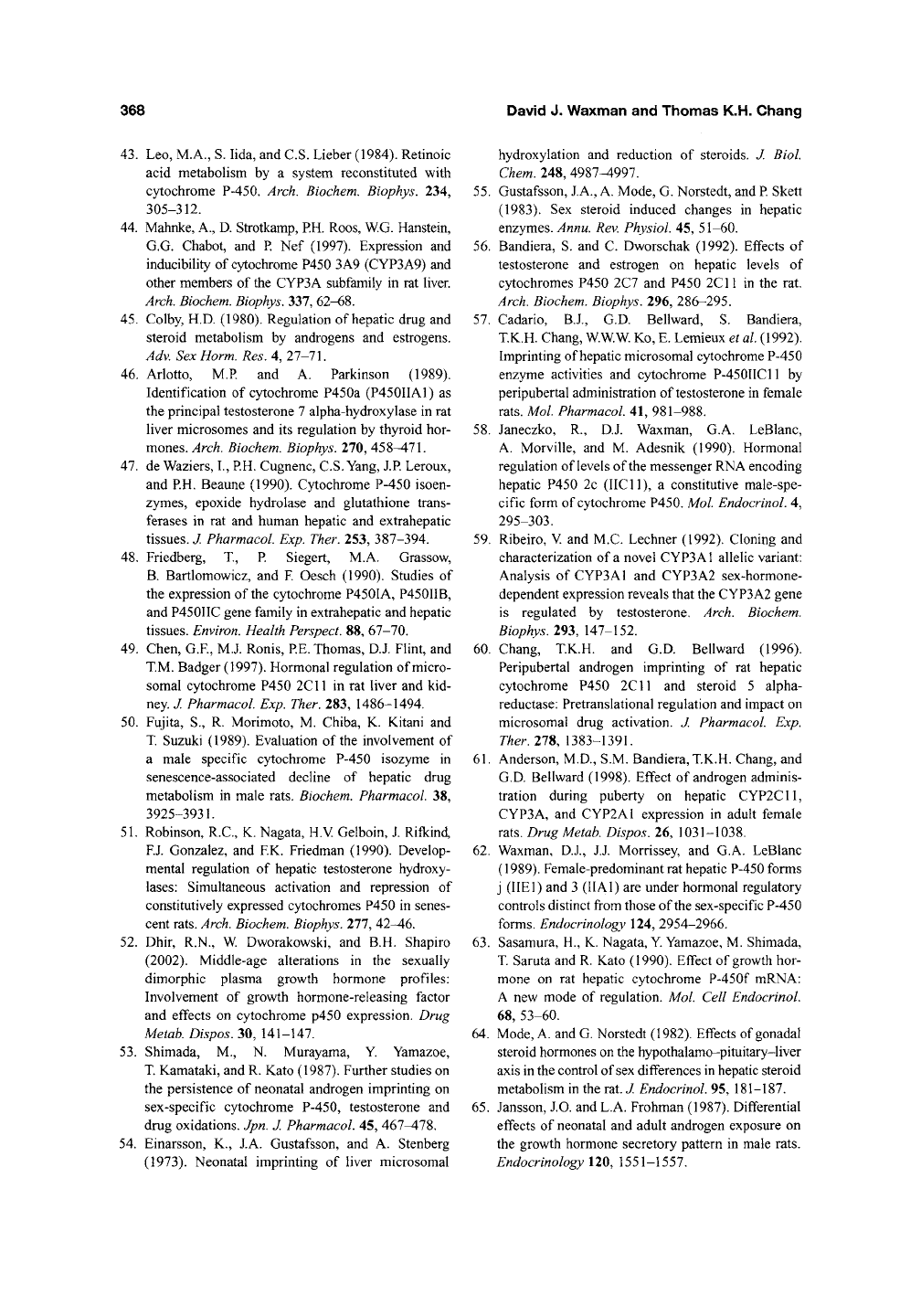
368
David J. Waxman and Thomas K.H. Chang
43.
Leo, M.A., S. lida, and C.S. Lieber (1984). Retinoic
acid metabolism by a system reconstituted with
cytochrome P-450. Arch. Biochem. Biophys. 234,
305-312.
44.
Mahnke, A., D. Strotkamp, P.H. Roos, W.G. Hanstein,
G.G. Chabot, and R Nef (1997). Expression and
inducibility of cytochrome P450 3A9 (CYP3A9) and
other members of the CYP3 A subfamily in rat liver.
Arch.
Biochem.
Biophys.
337, 62-68.
45.
Colby, H.D. (1980). Regulation of hepatic drug and
steroid metabolism by androgens and estrogens.
Adv. Sex Norm. Res. 4,
27-71.
46.
Arlotto, M.R and A. Parkinson (1989).
Identification of cytochrome P450a (P450I1A1) as
the principal testosterone 7 alpha-hydroxylase in rat
liver microsomes and its regulation by thyroid hor-
mones. Arch. Biochem. Biophys. 270,
458^71.
47.
de Waziers, I., RH. Cugnenc,
C.S.
Yang,
J.R Leroux,
and RH. Beaune (1990). Cytochrome P-450 isoen-
zymes, epoxide hydrolase and glutathione trans-
ferases in rat and human hepatic and extrahepatic
tissues.
J.
Pharmacol. Exp. Ther. 253, 387-394.
48.
Friedberg, T., P. Siegert, M.A. Grassow,
B.
Bartlomowicz, and R Oesch (1990). Studies of
the expression of the cytochrome P4501A, P4501IB,
and P4501IC gene family in extrahepatic and hepatic
tissues.
Environ.
Health Perspect. 88, 67-70.
49.
Chen, G.F, M.J. Ronis, RE. Thomas, D.J. Fhnt, and
T.M. Badger (1997). Hormonal regulation of micro-
somal cytochrome P450 2C11 in rat liver and kid-
ney J. Pharmacol. Exp. Ther. 283, 1486-1494.
50.
Fujita, S., R. Morimoto, M. Chiba, K. Kitani and
T. Suzuki (1989). Evaluation of the involvement of
a male specific cytochrome P-450 isozyme in
senescence-associated decline of hepatic drug
metaboHsm in male rats. Biochem. Pharmacol. 38,
3925-3931.
51.
Robinson, R.C., K. Nagata, H.V Gelboin, J. Rifkind,
F.J. Gonzalez, and FK. Friedman (1990). Develop-
mental regulation of hepatic testosterone hydroxy-
lases:
Simultaneous activation and repression of
constitutively expressed cytochromes P450 in senes-
cent rats.
Arch.
Biochem. Biophys. 277, 42-46.
52.
Dhir, R.N., W. Dworakowski, and B.H. Shapiro
(2002).
Middle-age alterations in the sexually
dimorphic plasma growth hormone profiles:
Involvement of growth hormone-releasing factor
and effects on cytochrome p450 expression. Drug
Metab. Dispos. 30, 141-147.
53.
Shimada, M., N. Murayama, Y. Yamazoe,
T. Kamataki, and R. Kato (1987). Further studies on
the persistence of neonatal androgen imprinting on
sex-specific cytochrome P-450, testosterone and
drug oxidations. Jpn. J. Pharmacol. 45, 467^78.
54.
Einarsson, K., J.A. Gustafsson, and A. Stenberg
(1973).
Neonatal imprinting of liver microsomal
hydroxylation and reduction of steroids. J. Biol.
Chem.
248, 4987-4997.
55.
Gustafsson, J.A., A. Mode, G. Norstedt, and
R
Skett
(1983).
Sex steroid induced changes in hepatic
enzymes. Annu. Rev. Physiol. 45, 51-60.
56.
Bandiera, S. and C. Dworschak (1992). Effects of
testosterone and estrogen on hepatic levels of
cytochromes P450 2C7 and P450 2C11 in the rat.
Arch.
Biochem. Biophys. 296, 286-295.
57.
Cadario, B.J., G.D. Bellward, S. Bandiera,
T.K.H. Chang,
W.W.W.
Ko, E. Lemieux et
at.
(1992).
Imprinting of hepatic microsomal cytochrome P-450
enzyme activities and cytochrome P-450IIC11 by
peripubertal administration of testosterone in female
rats.
Mol. Pharmacol. 41, 981-988.
58.
Janeczko, R., D.J. Waxman, G.A. LeBlanc,
A. Morville, and M. Adesnik (1990). Hormonal
regulation of levels of the messenger RNA encoding
hepatic P450 2c (IICU), a constitutive male-spe-
cific form of cytochrome P450. Mol. Endocrinol. 4,
295-303.
59.
Ribeiro, V. and M.C. Lechner (1992). Cloning and
characterization of a novel CYP3A1 allelic variant:
Analysis of CYP3A1 and CYP3A2 sex-hormone-
dependent expression reveals that the CYP3A2 gene
is regulated by testosterone. Arch. Biochem.
Biophys. 293, 147-152.
60.
Chang, T.K.H. and G.D. Bellward (1996).
Peripubertal androgen imprinting of rat hepatic
cytochrome P450 2C11 and steroid 5 alpha-
reductase: Pretranslational regulation and impact on
microsomal drug activation. J. Pharmacol. Exp.
Ther.UH,
1383-1391.
61.
Anderson, M.D., S.M. Bandiera, T.K.H. Chang, and
G.D. Bellward (1998). Effect of androgen adminis-
tration during puberty on hepatic CYP2C11,
CYP3A, and CYP2A1 expression in adult female
rats.
Drug
Metab.
Dispos. 26, 1031-1038.
62.
Waxman, D.J., J.J. Morrissey, and G.A. LeBlanc
(1989).
Female-predominant rat hepatic P-450 forms
j (IIEI) and 3 (IIAl) are under hormonal regulatory
controls distinct from those of the sex-specific P-450
forms.
Endocrinology 124, 2954-2966.
63.
Sasamura, H., K. Nagata, Y Yamazoe, M. Shimada,
T. Saruta and R. Kato (1990). Effect of growth hor-
mone on rat hepatic cytochrome P-450f mRNA:
A new mode of regulation. Mol. Cell Endocrinol.
68,
53-60.
64.
Mode, A. and G. Norstedt (1982). Effects of gonadal
steroid hormones on the hypothalamo-pituitary-liver
axis in the control of sex differences in hepatic steroid
metabolism in the rat. J. Endocrinol. 95, 181-187.
65.
Jansson, J.O. and L.A. Frohman (1987). Differential
effects of neonatal and adult androgen exposure on
the growth hormone secretory pattern in male rats.
Endocrinology 120, 1551-1557.
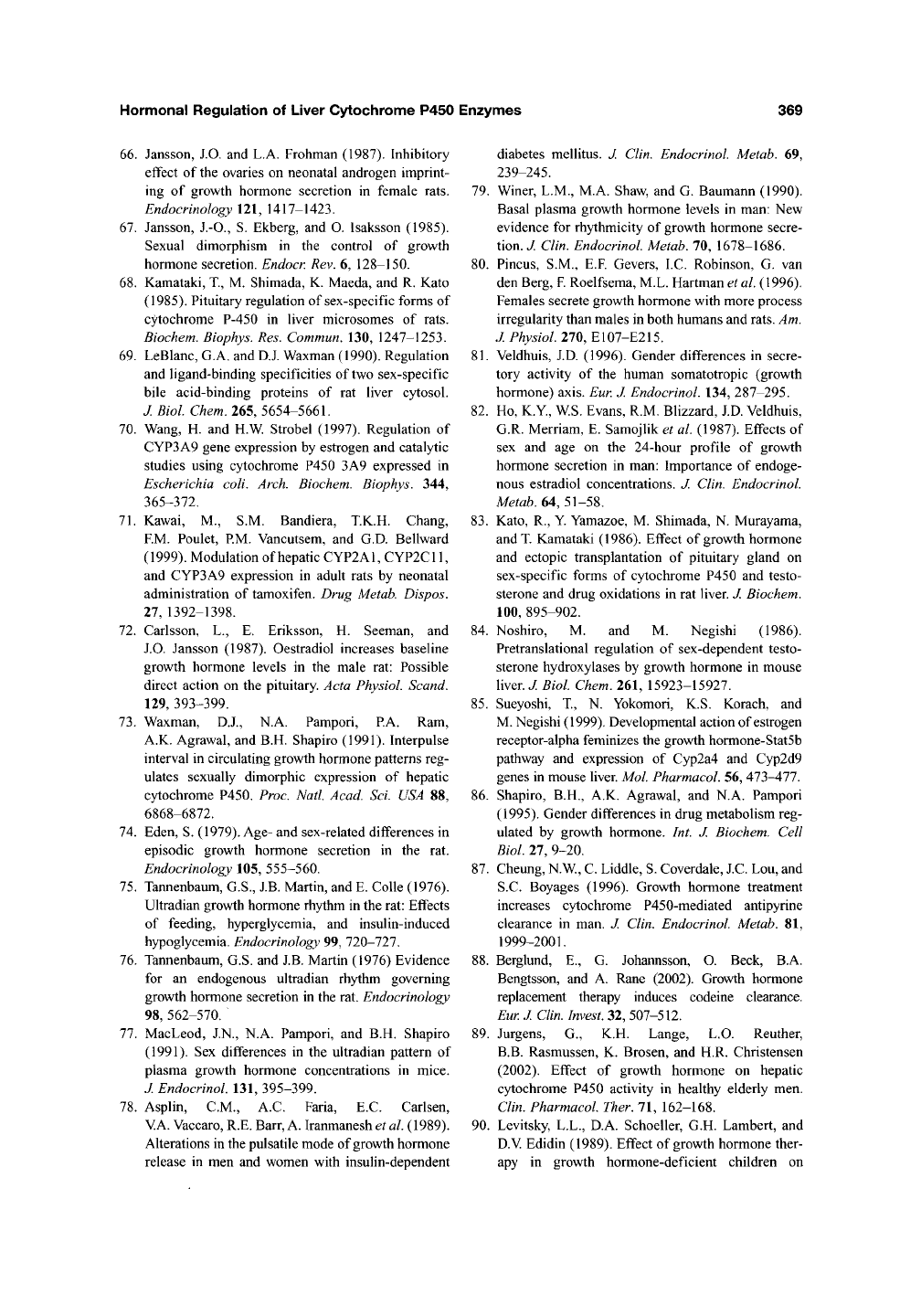
Hormonal Regulation of Liver Cytochrome P450 Enzymes
369
66.
Jansson, J.O. and L.A. Frohman (1987). Inhibitory
effect of the ovaries on neonatal androgen imprint-
ing of growth hormone secretion in female rats.
Endocrinology 121, 1417-1423.
67.
Jansson, J.-O., S. Ekberg, and O. Isaksson (1985).
Sexual dimorphism in the control of growth
hormone secretion. Endocr. Rev. 6, 128-150.
68.
Kamataki, T., M. Shimada, K. Maeda, and R. Kato
(1985).
Pituitary regulation of sex-specific forms of
cytochrome P-450 in liver microsomes of rats.
Biochem. Biophys. Res. Commun. 130, 1247-1253.
69.
LeBlanc, G.A. and D.J. Waxman (1990). Regulation
and ligand-binding specificities of two sex-specific
bile acid-binding proteins of rat liver cytosol.
J. Biol. Chem. 265, 5654-5661.
70.
Wang, H. and H.W. Strobel (1997). Regulation of
CYP3A9 gene expression by estrogen and catalytic
studies using cytochrome P450 3A9 expressed in
Escherichia coli. Arch. Biochem. Biophys. 344,
365-372.
71.
Kawai, M., S.M. Bandiera, T.K.H. Chang,
P.M. Poulet, P.M. Vancutsem, and G.D. Bellward
(1999).
Modulation of hepatic CYP2A1, CYP2C11,
and CYP3A9 expression in adult rats by neonatal
administration of tamoxifen. Drug Metab. Dispos.
27,1392-1398.
72.
Carlsson, L., E. Eriksson, H. Seeman, and
J.O.
Jansson (1987). Oestradiol increases baseline
growth hormone levels in the male rat: Possible
direct action on the pituitary. Acta Physiol.
Scand.
129,
393-399.
73.
Waxman, D.J., N.A. Pampori, RA. Ram,
A.K. Agrawal, and B.H. Shapiro (1991). Interpulse
interval in circulating growth hormone patterns reg-
ulates sexually dimorphic expression of hepatic
cytochrome P450. Proc. Natl.
Acad.
Sci. USA 88,
6868-6872.
74.
Eden, S. (1979). Age- and sex-related differences in
episodic growth hormone secretion in the rat.
Endocrinology 105, 555-560.
75.
Tannenbaum, G.S., J.B. Martin, and E. Colle (1976).
Ultradian growth hormone rhythm in the rat: Effects
of feeding, hyperglycemia, and insulin-induced
hypoglycemia. Endocrinology 99, 720-727.
76.
Tannenbaum, G.S. and J.B. Martin (1976) Evidence
for an endogenous ultradian rhythm governing
growth hormone secretion in the rat. Endocrinology
98,
562-570.
77.
MacLeod, J.N., N.A. Pampori, and B.H. Shapiro
(1991).
Sex differences in the ultradian pattern of
plasma growth hormone concentrations in mice.
J. Endocrinol. 131, 395-399.
78.
Asplin, CM., A.C. Faria, E.G. Carlsen,
VA. Vaccaro, R.E. Barr,
A.
Iranmanesh et
al.
(1989).
Alterations in the pulsatile mode of growth hormone
release in men and women with insulin-dependent
diabetes mellitus. J. Clin. Endocrinol. Metab. 69,
239-245.
79.
Winer, L.M., M.A. Shaw, and G. Baumann (1990).
Basal plasma growth hormone levels in man: New
evidence for rhythmicity of growth hormone secre-
tion. J. Clin. Endocrinol. Metab. 70, 1678-1686.
80.
Pincus, S.M., E.F. Gevers, I.C. Robinson, G. van
den Berg,
F.
Roelfsema, M.L. Hartman et al. (1996).
Females secrete growth hormone with more process
irregularity than males in both humans and rats. Am.
J. Physiol. 270, E107-E215.
81.
Veldhuis, J.D. (1996). Gender differences in secre-
tory activity of the human somatotropic (growth
hormone) axis. Eur J. Endocrinol. 134, 287-295.
82.
Ho, K.Y., WS. Evans, R.M. Blizzard, J.D. Veldhuis,
G.R. Merriam, E. Samojlik et al. (1987). Effects of
sex and age on the 24-hour profile of growth
hormone secretion in man: Importance of endoge-
nous estradiol concentrations. J. Clin. Endocrinol.
Metab. 64,
5\-5H.
83.
Kato, R., Y Yamazoe, M. Shimada, N. Murayama,
and T. Kamataki (1986). Effect of growth hormone
and ectopic transplantation of pituitary gland on
sex-specific forms of cytochrome P450 and testo-
sterone and drug oxidations in rat liver. J. Biochem.
100,
895-902.
84.
Noshiro, M. and M. Negishi (1986).
Pretranslational regulation of sex-dependent testo-
sterone hydroxylases by growth hormone in mouse
liver. J. Biol. Chem. 261, 15923-15927.
85.
Sueyoshi, T., N. Yokomori, K.S. Korach, and
M. Negishi (1999). Developmental action of estrogen
receptor-alpha feminizes the growth hormone-Stat5b
pathway and expression of Cyp2a4 and Cyp2d9
genes in mouse liver. Mol. Pharmacol. 56, 473^77.
86.
Shapiro, B.H., A.K. Agrawal, and N.A. Pampori
(1995).
Gender differences in drug metabolism reg-
ulated by growth hormone. Int. J. Biochem. Cell
Biol. 27, 9-20.
87.
Cheung, N.W, C. Liddle, S. Coverdale, J.C. Lou, and
S.C. Boyages (1996). Growth hormone treatment
increases cytochrome P450-mediated antipyrine
clearance in man. J. Clin. Endocrinol. Metab. 81,
1999-2001.
88.
Berglund, E., G. Johannsson, O. Beck, B.A.
Bengtsson, and A. Rane (2002). Growth hormone
replacement therapy induces codeine clearance.
Eur J.
Clin.
Invest.
32, 507-512.
89.
Jurgens, G., K.H. Lange, L.O. Reuther,
B.B.
Rasmussen, K. Brosen, and H.R. Christensen
(2002).
Effect of growth hormone on hepatic
cytochrome P450 activity in healthy elderly men.
Clin.
Pharmacol. Ther. 71, 162-168.
90.
Levitsky, L.L., D.A. Schoeller, G.H. Lambert, and
D.V Edidin (1989). Effect of growth hormone ther-
apy in growth hormone-deficient children on
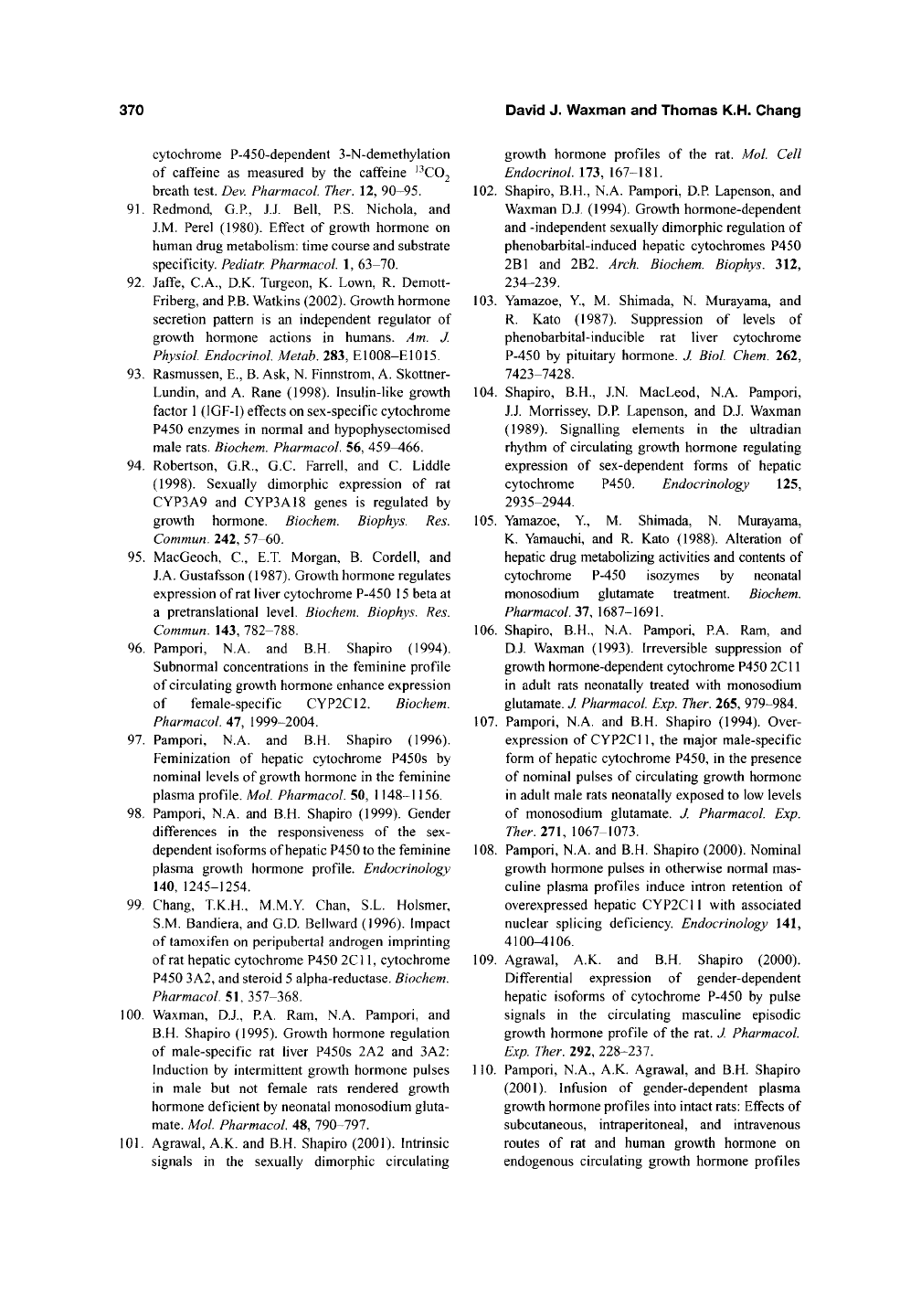
370 David J. Waxman and Thomas K.H. Chang
cytochrome P-450-dependent 3-N-demethylation
of caffeine as measured by the caffeine ^^C02
breath test.
Dev.
Pharmacol. Ther. 12, 90-95.
91.
Redmond, G.P., J.J. Bell, P.S. Nichola, and
J.M. Perel (1980). Effect of growth hormone on
human drug metabolism: time course and substrate
specificity.
Pediatr.
Pharmacol. 1, 63-70.
92.
Jaffe, C.A., D.K. Turgeon, K. Lown, R. Demott-
Friberg, and
P.B.
Watkins (2002). Growth hormone
secretion pattern is an independent regulator of
growth hormone actions in humans. Am. J.
Physiol. Endocrinol. Metab. 283, E1008-E1015.
93.
Rasmussen, E., B. Ask, N. Finnstrom, A. Skottner-
Lundin, and A. Rane (1998). Insulin-like growth
factor
1
(lGF-1) effects on sex-specific cytochrome
P450 enzymes in normal and hypophysectomised
male rats. Biochem. Pharmacol. 56, 459^66.
94.
Robertson, G.R., G.C. Farrell, and C. Liddle
(1998).
Sexually dimorphic expression of rat
CYP3A9 and CYP3A18 genes is regulated by
growth hormone. Biochem. Biophys. Res.
Commun. 242, 57-60.
95.
MacGeoch, C, E.T. Morgan, B. Cordell, and
J.A. Gustafsson (1987). Growth hormone regulates
expression of rat liver cytochrome P-450 15 beta at
a pretranslational level. Biochem. Biophys. Res.
Commun. 143, 782-788.
96.
Pampori, N.A. and B.H. Shapiro (1994).
Subnormal concentrations in the feminine profile
of circulating growth hormone enhance expression
of female-specific CYP2C12. Biochem.
Pharmacol. 47, 1999-2004.
97.
Pampori, N.A. and B.H. Shapiro (1996).
Feminization of hepatic cytochrome P450s by
nominal levels of growth hormone in the feminine
plasma profile. Mol. Pharmacol. 50, 1148-1156.
98.
Pampori, N.A. and B.H. Shapiro (1999). Gender
differences in the responsiveness of the sex-
dependent isoforms of hepatic P450 to the feminine
plasma growth hormone profile. Endocrinology
140,
1245-1254.
99.
Chang, T.K.H., M.M.Y. Chan, S.L. Holsmer,
S.M. Bandiera, and G.D. Bellward (1996). Impact
of tamoxifen on peripubertal androgen imprinting
of rat hepatic cytochrome P450 2C11, cytochrome
P450 3A2, and steroid 5 alpha-reductase. Biochem.
Pharmacol. 51,357-368.
100.
Waxman, D.J., PA. Ram, N.A. Pampori, and
B.H. Shapiro (1995). Growth hormone regulation
of male-specific rat liver P450s 2A2 and 3A2:
Induction by intermittent growth hormone pulses
in male but not female rats rendered growth
hormone deficient by neonatal monosodium gluta-
mate. Mol. Pharmacol. 48, 790-797.
101.
Agrawal, A.K. and B.H. Shapiro (2001). Intrinsic
signals in the sexually dimorphic circulating
growth hormone profiles of the rat. Mol. Cell
Endocrinol, li:^,
167-181.
102.
Shapiro, B.H., N.A. Pampori, D.P. Lapenson, and
Waxman D.J. (1994). Growth hormone-dependent
and -independent sexually dimorphic regulation of
phenobarbital-induced hepatic cytochromes P450
2B1 and 2B2. Arch. Biochem. Biophys. 312,
234-239.
103.
Yamazoe, Y, M. Shimada, N. Murayama, and
R. Kato (1987). Suppression of levels of
phenobarbital-inducible rat liver cytochrome
P-450 by pituitary hormone. J. Biol. Chem. 262,
7423-7428.
104.
Shapiro, B.H., J.N. MacLeod, N.A. Pampori,
J.J. Morrissey, D.P. Lapenson, and D.J. Waxman
(1989).
Signalling elements in the ultradian
rhythm of circulating growth hormone regulating
expression of sex-dependent forms of hepatic
cytochrome P450. Endocrinology 125,
2935-2944.
105.
Yamazoe, Y, M. Shimada, N. Murayama,
K. Yamauchi, and R. Kato (1988). Alteration of
hepatic drug metabolizing activities and contents of
cytochrome P-450 isozymes by neonatal
monosodium glutamate treatment. Biochem.
Pharmacol.
2^1,
1687-1691.
106.
Shapiro, B.H., N.A. Pampori, PA. Ram, and
D.J. Waxman (1993). Irreversible suppression of
growth hormone-dependent cytochrome P450 2C11
in adult rats neonatally treated with monosodium
glutamate.
J.
Pharmacol. Exp. Ther. 265, 979-984.
107.
Pampori, N.A. and B.H. Shapiro (1994). Over-
expression of CYP2C11, the major male-specific
form of hepatic cytochrome P450, in the presence
of nominal pulses of circulating growth hormone
in adult male rats neonatally exposed to low levels
of monosodium glutamate. J. Pharmacol. Exp.
Ther. Ill, 1067-1073.
108.
Pampori, N.A. and B.H. Shapiro (2000). Nominal
growth hormone pulses in otherwise normal mas-
culine plasma profiles induce intron retention of
overexpressed hepatic CYP2C11 with associated
nuclear splicing deficiency. Endocrinology 141,
4100-4106.
109.
Agrawal, A.K. and B.H. Shapiro (2000).
Differential expression of gender-dependent
hepatic isoforms of cytochrome P-450 by pulse
signals in the circulating masculine episodic
growth hormone profile of the rat. J. Pharmacol.
Exp.
Ther. 292, 228-237.
110.
Pampori, N.A., A.K. Agrawal, and B.H. Shapiro
(2001).
Infusion of gender-dependent plasma
growth hormone profiles into intact
rats:
Effects of
subcutaneous, intraperitoneal, and intravenous
routes of rat and human growth hormone on
endogenous circulating growth hormone profiles
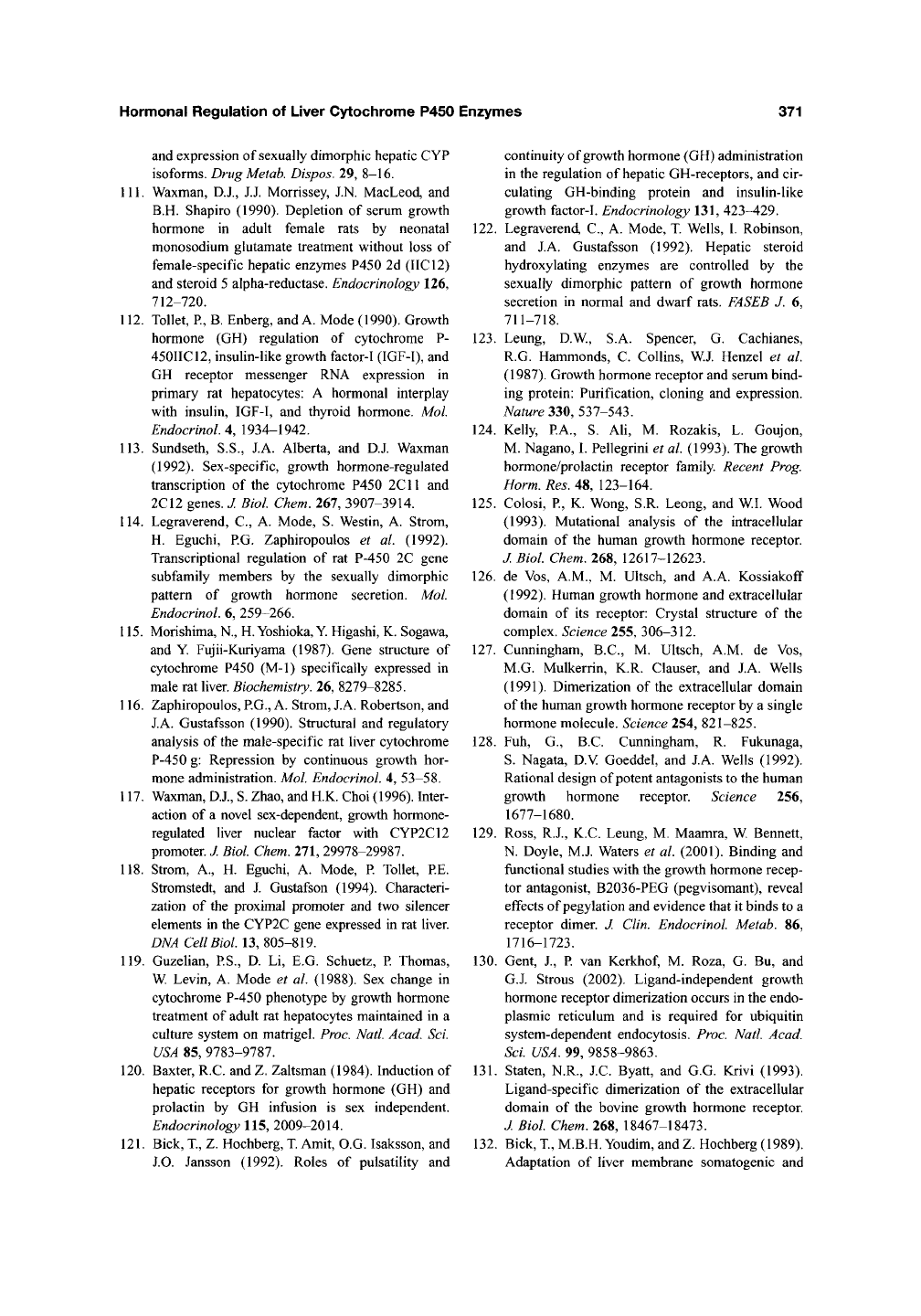
Hormonal Regulation of Liver Cytochrome P450 Enzymes 371
and expression of sexually dimorphic hepatic C YP
isoforms. Drug
Metab.
Dispos. 29, 8-16.
111.
Waxman, D.J., J.J. Morrissey, J.N. MacLeod, and
B.H. Shapiro (1990). Depletion of serum growth
hormone in adult female rats by neonatal
monosodium glutamate treatment without loss of
female-specific hepatic enzymes P450 2d (TIC 12)
and steroid 5 alpha-reductase. Endocrinology 126,
712-720.
112.
Toilet, P., B. Enberg, and A. Mode (1990). Growth
hormone (GH) regulation of cytochrome P-
450IIC12, insulin-like growth factor-I (IGF-I), and
GH receptor messenger RNA expression in
primary rat hepatocytes: A hormonal interplay
with insulin, IGF-I, and thyroid hormone. Mol.
Endocrinol. 4, 1934-1942.
113.
Sundseth, S.S., J.A. Alberta, and D.J. Waxman
(1992).
Sex-specific, growth hormone-regulated
transcription of the cytochrome P450 2C11 and
2C12 genes. J. Biol Chem. 267, 3907-3914.
114.
Legraverend, C, A. Mode, S. Westin, A. Strom,
H. Eguchi, PG. Zaphiropoulos et al. (1992).
Transcriptional regulation of rat P-450 2C gene
subfamily members by the sexually dimorphic
pattern of growth hormone secretion. Mol.
Endocrinol. 6, 259-266.
115.
Morishima, N.,
H.
Yoshioka,
Y.
Higashi, K. Sogawa,
and Y. Fujii-Kuriyama (1987). Gene structure of
cytochrome P450 (M-1) specifically expressed in
male rat liver. Biochemistry. 26, 8279-8285.
116.
Zaphiropoulos,
P.G.,
A.
Strom, J.A. Robertson, and
J.A. Gustafsson (1990). Structural and regulatory
analysis of the male-specific rat liver cytochrome
P-450 g: Repression by continuous growth hor-
mone administration. Mol. Endocrinol. 4, 53-58.
117.
Waxman, D.J., S. Zhao, and H.K. Choi (1996). Inter-
action of a novel sex-dependent, growth hormone-
regulated liver nuclear factor with CYP2C12
promoter. J. Biol. Chem. 211, 29978-29987.
118.
Strom, A., H. Eguchi, A. Mode, P Toilet, PE.
Stromstedt, and J. Gustafson (1994). Characteri-
zation of the proximal promoter and two silencer
elements in the CYP2C gene expressed in rat liver.
DNA
Cell
Biol.
13, 805-819.
119.
Guzelian, PS., D. Li, E.G. Schuetz, P Thomas,
W. Levin, A. Mode et al. (1988). Sex change in
cytochrome P-450 phenotype by growth hormone
treatment of adult rat hepatocytes maintained in a
culture system on matrigel. Proc. Natl.
Acad.
Sci.
USA 85, 9783-9787.
120.
Baxter, R.C. and Z. Zaltsman (1984). Induction of
hepatic receptors for growth hormone (GH) and
prolactin by GH infusion is sex independent.
Endocrinology 115, 2009-2014.
121.
Bick, T, Z. Hochberg, T Amit, O.G. Isaksson, and
J.O.
Jansson (1992). Roles of pulsatility and
continuity of growth hormone (GH) administration
in the regulation of hepatic GH-receptors, and cir-
culating GH-binding protein and insulin-like
growth factor-I. Endocrinology 131, 423^29.
122.
Legraverend, C, A. Mode, T. Wells, 1. Robinson,
and J.A. Gustafsson (1992). Hepatic steroid
hydroxylating enzymes are controlled by the
sexually dimorphic pattern of growth hormone
secretion in normal and dwarf rats. E4SEB J. 6,
711-718.
123.
Leung, D.W, S.A. Spencer, G. Cachianes,
R.G. Hammonds, C. Collins, W.J. Henzel et al.
(1987).
Growth hormone receptor and serum bind-
ing protein: Purification, cloning and expression.
Nature 330, 531-543.
124.
Kelly, PA., S. Ali, M. Rozakis, L. Goujon,
M. Nagano, I. Pellegrini et al. (1993). The growth
hormone/prolactin receptor family. Recent Prog.
Horm.
Res. 48, 123-164.
125.
Colosi, P, K. Wong, S.R. Leong, and W.I. Wood
(1993).
Mutational analysis of the intracellular
domain of the human growth hormone receptor.
J. Biol. Chem. 268, 12617-12623.
126.
de Vos, A.M., M. Ultsch, and A.A. Kossiakoff
(1992).
Human growth hormone and extracellular
domain of its receptor: Crystal structure of the
complex. Science 255, 306-312.
127.
Cunningham, B.C., M. Ultsch, A.M. de Vos,
M.G. Mulkerrin, K.R. Clauser, and J.A. Wells
(1991).
Dimerization of the extracellular domain
of the human growth hormone receptor by a single
hormone molecule. Science 254, 821-825.
128.
Fuh, G., B.C. Cunningham, R. Fukunaga,
S. Nagata, D.V Goeddel, and J.A. Wells (1992).
Rational design of potent antagonists to the human
growth hormone receptor. Science 256,
1677-1680.
129.
Ross, R.J., K.C. Leung, M. Maamra, W Bennett,
N.
Doyle, M.J. Waters et al. (2001). Binding and
functional studies with the growth hormone recep-
tor antagonist, B2036-PEG (pegvisomant), reveal
effects of pegylation and evidence that it binds to a
receptor dimer. J. Clin. Endocrinol. Metab. 86,
1716-1723.
130.
Gent, J., P van
Kerkhof,
M. Roza, G. Bu, and
G.J. Strous (2002). Ligand-independent growth
hormone receptor dimerization occurs in the endo-
plasmic reticulum and is required for ubiquitin
system-dependent endocytosis. Proc. Natl.
Acad.
Sci. USA. 99, 9858-9863.
131.
Staten, N.R., J.C. Byatt, and G.G. Krivi (1993).
Ligand-specific dimerization of the extracellular
domain of the bovine growth hormone receptor.
J. Biol. Chem. 268, 18467-18473.
132.
Bick, T, M.B.H. Youdim, and Z. Hochberg (1989).
Adaptation of liver membrane somatogenic and
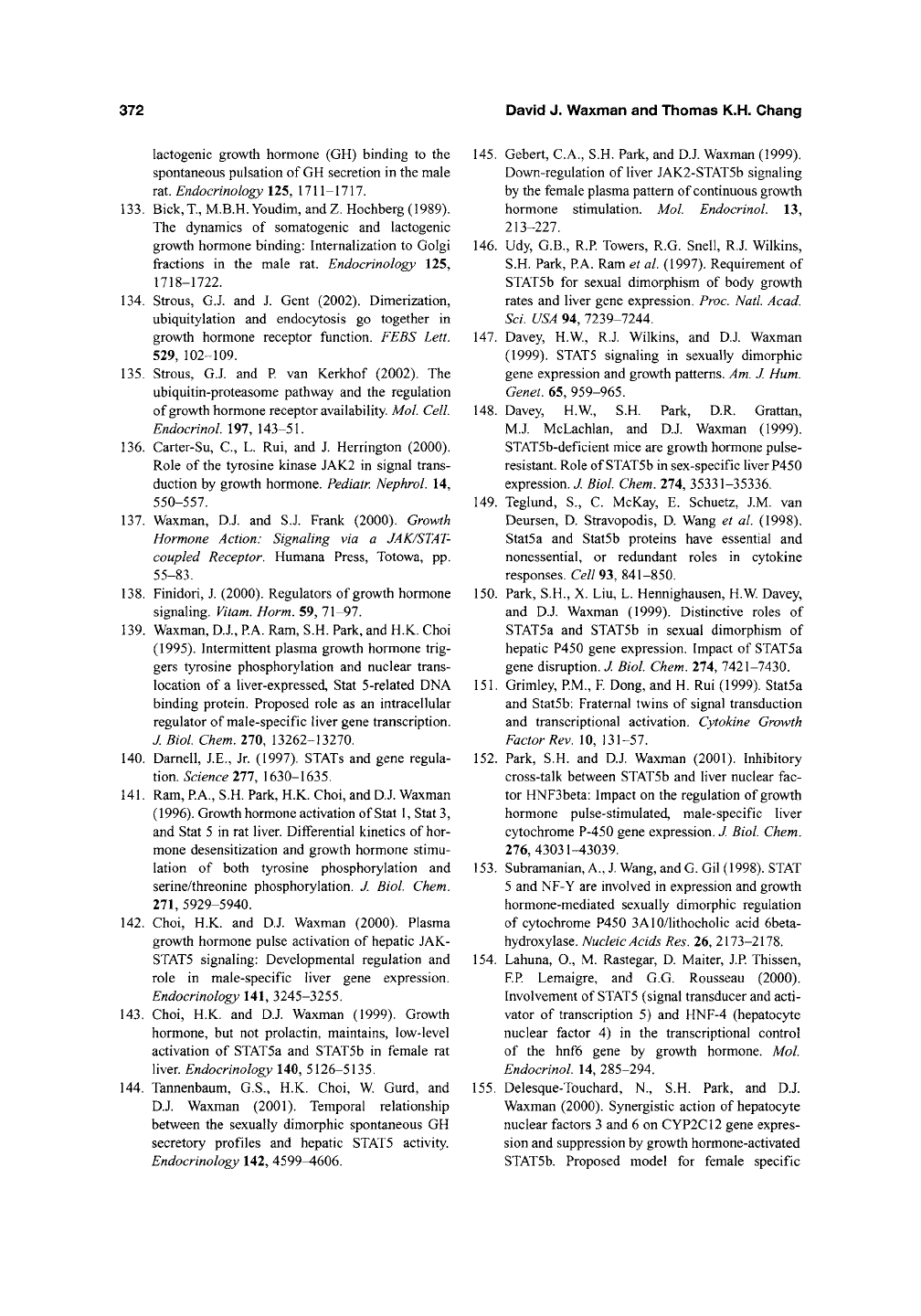
372 David J. Waxman and Thomas K.H. Chang
lactogenic growth hormone (GH) binding to the
spontaneous pulsation of GH secretion in the male
rat. Endocrinology 125, 1711-1717.
133.
Bick, T., M.B.H. Youdim, and Z. Hochberg (1989).
The dynamics of somatogenic and lactogenic
growth hormone binding: Internalization to Golgi
fractions in the male rat. Endocrinology 125,
1718-1722.
134.
Strous, G.J. and J. Gent (2002). Dimerization,
ubiquitylation and endocytosis go together in
growth hormone receptor fiinction. FEBS Lett.
529,
102-109.
135.
Strous, G.J. and P. van Kerkhof (2002). The
ubiquitin-proteasome pathway and the regulation
of growth hormone receptor availability. Mol. Cell.
Endocrinol. 197,
143-51.
136.
Carter-Su, C, L. Rui, and J. Herrington (2000).
Role of the tyrosine kinase JAK2 in signal trans-
duction by growth hormone. Pediatr Nephrol. 14,
550-557.
137.
Waxman, D.J. and S.J. Frank (2000). Growth
Hormone Action: Signaling via a JAK/STAT-
coupled Receptor. Humana Press, Totowa, pp.
55-83.
138.
Finidori, J. (2000). Regulators of growth hormone
signaling.
Vitam.
Norm. 59, 71-97.
139.
Waxman, D.J., PA. Ram, S.H. Park, and H.K. Choi
(1995).
Intermittent plasma growth hormone trig-
gers tyrosine phosphorylation and nuclear trans-
location of a liver-expressed, Stat 5-related DNA
binding protein. Proposed role as an intracellular
regulator of male-specific liver gene transcription.
J. Biol. Chem. 270, 13262-13270.
140.
Darnell, J.E., Jr. (1997). STATs and gene regula-
tion. Science 277, 1630-1635.
141.
Ram, PA., S.H. Park, H.K. Choi, and D.J. Waxman
(1996).
Growth hormone activation of Stat 1, Stat 3,
and Stat 5 in rat liver. Differential kinetics of hor-
mone desensitization and growth hormone stimu-
lation of both tyrosine phosphorylation and
serine/threonine phosphorylation. J. Biol. Chem.
211,
5929-5940.
142.
Choi, H.K. and D.J. Waxman (2000). Plasma
growth hormone pulse activation of hepatic JAK-
STAT5 signaling: Developmental regulation and
role in male-specific liver gene expression.
Endocrinology 141, 3245-3255.
143.
Choi, H.K. and D.J. Waxman (1999). Growth
hormone, but not prolactin, maintains, low-level
activation of STAT5a and STAT5b in female rat
liver. Endocrinology 140, 5126-5135.
144.
Tannenbaum, G.S., H.K. Choi, W Gurd, and
D.J. Waxman (2001). Temporal relationship
between the sexually dimorphic spontaneous GH
secretory profiles and hepatic STAT5 activity.
Endocrinology 142, 4599^606.
145.
Gebert, C.A., S.H. Park, and D.J. Waxman (1999).
Down-regulation of liver JAK2-STAT5b signaling
by the female plasma pattern of continuous growth
hormone stimulation. Mol. Endocrinol. 13,
213-227.
146.
Udy, G.B., R.P Towers, R.G. Snell, R.J. Wilkins,
S.H. Park, PA. Ram et al. (1997). Requirement of
STAT5b for sexual dimorphism of body growth
rates and liver gene expression. Proc. Nad.
Acad.
Sci. USA 94, 7239-7244.
147.
Davey, H.W, R.J. Wilkins, and D.J. Waxman
(1999).
STAT5 signaling in sexually dimorphic
gene expression and growth patterns. Am. J. Hum.
Genet. 65, 959-965.
148.
Davey, H.W, S.H. Park, DR. Grattan,
M.J. McLachlan, and D.J. Waxman (1999).
STAT5b-deficient mice are growth hormone pulse-
resistant. Role of STAT5b in sex-specific liver P450
expression. J. Biol. Chem. 274, 35331-35336.
149.
Teglund, S., C. McKay, E. Schuetz, J.M. van
Deursen, D. Stravopodis, D. Wang et al. (1998).
Stat5a and Stat5b proteins have essential and
nonessential, or redundant roles in cytokine
responses. C^//93, 841-850.
150.
Park, S.H., X. Liu, L. Hennighausen, H.W. Davey,
and D.J. Waxman (1999). Distinctive roles of
STAT5a and STAT5b in sexual dimorphism of
hepatic P450 gene expression. Impact of STAT5a
gene disruption.
J.
Biol. Chem. 11
A,
7421-7430.
151.
Grimley, PM., F Dong, and H. Rui (1999). Stat5a
and Stat5b: Fraternal twins of signal transduction
and transcriptional activation. Cytokine Growth
Factor Rev. 10, 131-57.
152.
Park, S.H. and DJ. Waxman (2001). Inhibitory
cross-talk between STAT5b and liver nuclear fac-
tor HNF3beta: Impact on the regulation of growth
hormone pulse-stimulated, male-specific liver
cytochrome P-450 gene expression.
J.
Biol. Chem.
276,43031-43039.
153.
Subramanian, A., J. Wang, and G. Gil (1998). STAT
5 and NF-Y are involved in expression and growth
hormone-mediated sexually dimorphic regulation
of cytochrome P450 3A10/lithocholic acid 6beta-
hydroxylase.
Nucleic
Acids Res. 26, 2173-2178.
154.
Lahuna, O., M. Rastegar, D. Maiter, J.P Thissen,
FP Lemaigre, and G.G. Rousseau (2000).
Involvement of
STAT5
(signal transducer and acti-
vator of transcription 5) and HNF-4 (hepatocyte
nuclear factor 4) in the transcriptional control
of the hnf6 gene by growth hormone. Mol.
Endocrinol. 14, 285-294.
155.
Delesque-Touchard, N., S.H. Park, and D.J.
Waxman (2000). Synergistic action of hepatocyte
nuclear factors 3 and 6 on CYP2C12 gene expres-
sion and suppression by growth hormone-activated
STAT5b. Proposed model for female specific
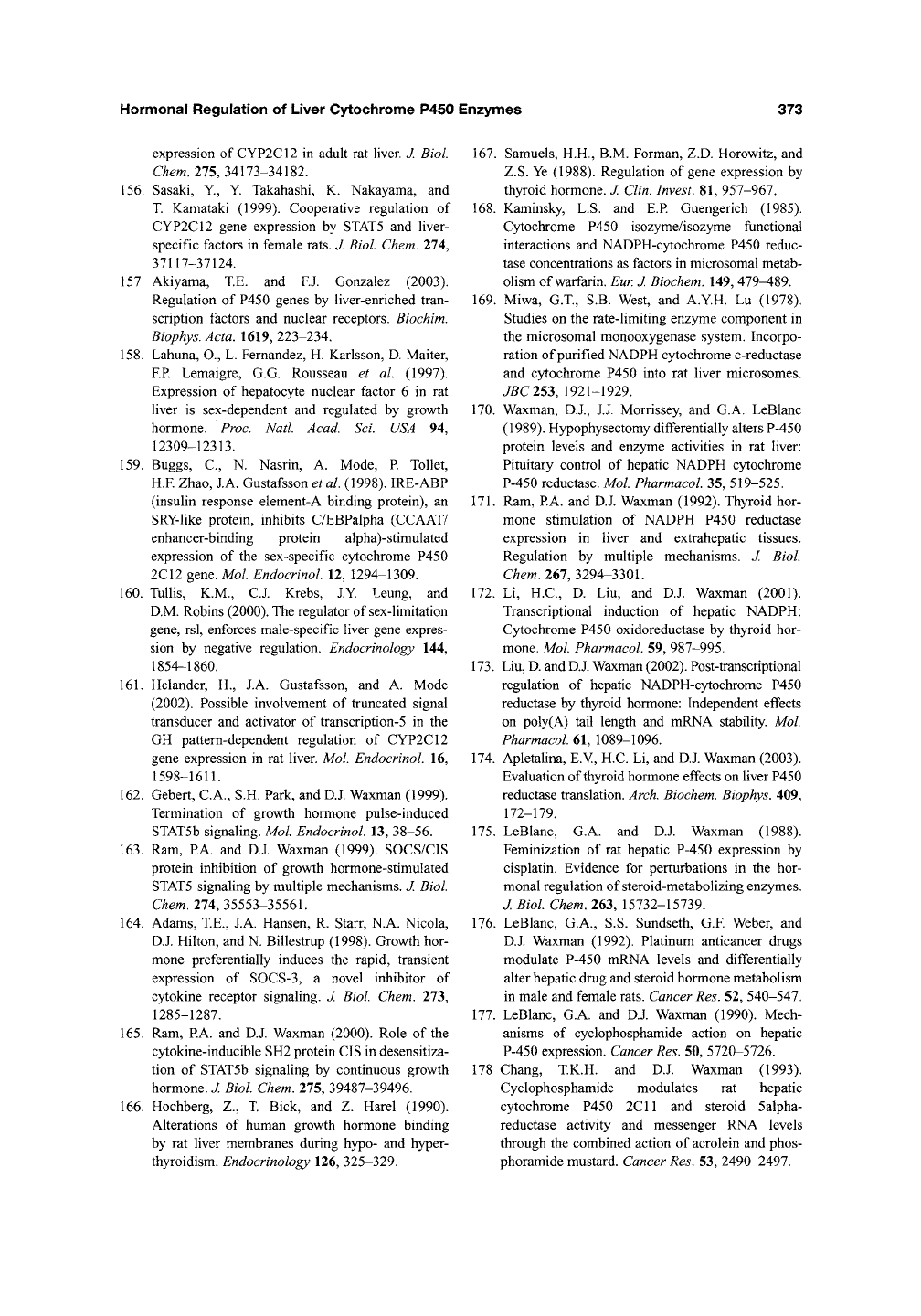
Hormonal Regulation of Liver Cytochrome P450 Enzymes
373
expression of CYP2C12 in adult rat liver. J. Biol.
Chem.
215, 34113-34^2.
156.
Sasaki, Y., Y. Takahashi, K. Nakayama, and
T. Kamataki (1999). Cooperative regulation of
CYP2C12 gene expression by STAT5 and liver-
specific factors in female rats. J. Biol. Chem. 274,
37117-37124.
157.
Akiyama, I.E. and F.J. Gonzalez (2003).
Regulation of P450 genes by liver-enriched tran-
scription factors and nuclear receptors. Biochim.
Biophys. Acta. 1619, 223-234.
158.
Lahuna, O., L. Fernandez, H. Karlsson, D. Maiter,
F.P.
Lemaigre, G.G. Rousseau et al. (1997).
Expression of hepatocyte nuclear factor 6 in rat
liver is sex-dependent and regulated by growth
hormone. Proc. Natl.
Acad.
Sci. USA 94,
12309-12313.
159.
Buggs, C., N. Nasrin, A. Mode, P Toilet,
H.F Zhao, J. A. Gustafsson et al. (1998). IRE-ABP
(insulin response element-A binding protein), an
SRY-like protein, inhibits C/EBPalpha (CCAAT/
enhancer-binding protein alpha)-stimulated
expression of the sex-specific cytochrome P450
2C12 gene. Mol. Endocrinol. 12, 1294-1309.
160.
TuUis, K.M., C.J. Krebs, J.Y. Leung, and
D.M. Robins (2000). The regulator of sex-limitation
gene,
rsl, enforces male-specific liver gene expres-
sion by negative regulation. Endocrinology 144,
1854-1860.
161.
Helander, H., J.A. Gustafsson, and A. Mode
(2002).
Possible involvement of truncated signal
transducer and activator of transcription-5 in the
GH pattern-dependent regulation of CYP2C12
gene expression in rat liver. Mol. Endocrinol. 16,
1598-1611.
162.
Gebert, C.A., S.H. Park, and D.J. Waxman (1999).
Termination of growth hormone pulse-induced
STAT5b signaling. Mol. Endocrinol. 13, 38-56.
163.
Ram, PA. and D.J. Waxman (1999). SOCS/CIS
protein inhibition of growth hormone-stimulated
STAT5 signaling by multiple mechanisms. J. Biol.
C/^em. 274, 35553-35561.
164.
Adams, T.E., J.A. Hansen, R. Starr, N.A. Nicola,
D.J. Hilton, and N. Billestrup (1998). Growth hor-
mone preferentially induces the rapid, transient
expression of SOCS-3, a novel inhibitor of
cytokine receptor signaling. J. Biol. Chem. 273,
1285-1287.
165.
Ram, PA. and D.J. Waxman (2000). Role of the
cytokine-inducible SH2 protein CIS in desensitiza-
tion of STAT5b signaling by continuous growth
hormone. J. Biol. Chem. 275, 39487-39496.
166.
Hochberg, Z., T Bick, and Z. Hard (1990).
Alterations of human growth hormone binding
by rat liver membranes during hypo- and hyper-
thyroidism. Endocrinology 126, 325-329.
167.
Samuels, H.H., B.M. Forman, Z.D. Horowitz, and
Z.S.
Ye (1988). Regulation of gene expression by
thyroid hormone. J. Clin. Invest. 81, 957-967.
168.
Kaminsky, L.S. and E.P Guengerich (1985).
Cytochrome P450 isozyme/isozyme functional
interactions and NADPH-cytochrome P450 reduc-
tase concentrations as factors in microsomal metab-
olism of warfarin. Eur J. Biochem. 149, 479^89.
169.
Miwa, G.T, S.B. West, and A.Y.H. Lu (1978).
Studies on the rate-limiting enzyme component in
the microsomal monooxygenase system. Incorpo-
ration of purified NADPH cytochrome c-reductase
and cytochrome P450 into rat liver microsomes.
JBC 253, 1921-1929.
170.
Waxman, D.J., J.J. Morrissey, and G.A. LeBlanc
(1989).
Hypophysectomy differentially alters P-450
protein levels and enzyme activities in rat liver:
Pituitary control of hepatic NADPH cytochrome
P-450 reductase. Mol. Pharmacol. 35, 519-525.
171.
Ram, PA. and D.J. Waxman (1992). Thyroid hor-
mone stimulation of NADPH P450 reductase
expression in liver and extrahepatic tissues.
Regulation by multiple mechanisms. J. Biol.
Chem.
261, 3294-3301.
172.
Li, H.C., D. Liu, and D.J. Waxman (2001).
Transcriptional induction of hepatic NADPH:
Cytochrome P450 oxidoreductase by thyroid hor-
mone. Mol. Pharmacol. 59, 987-995.
173.
Liu,
D.
and
D.J.
Waxman
(2002).
Post-transcriptional
regulation of hepatic NADPH-cytochrome P450
reductase by thyroid hormone: Independent effects
on poly(A) tail length and mRNA stability. Mol.
Pharmacol. 61, 1089-1096.
174.
Apletalina, E.V, H.C. Li, and D.J. Waxman (2003).
Evaluation of thyroid hormone effects on liver P450
reductase translation. Arch. Biochem. Biophys. 409,
172-179.
175.
LeBlanc, G.A. and D.J. Waxman (1988).
Feminization of rat hepatic P-450 expression by
cisplatin. Evidence for perturbations in the hor-
monal regulation of steroid-metabolizing enzymes.
J. Biol. Chem. 263, 15732-15739.
176.
LeBlanc, G.A., S.S. Sundseth, G.F. Weber, and
D.J. Waxman (1992). Platinum anticancer drugs
modulate P-450 mRNA levels and differentially
alter hepatic drug and steroid hormone metabolism
in male and female rats. Cancer Res. 52, 540-547.
177.
LeBlanc, G.A. and D.J. Waxman (1990). Mech-
anisms of cyclophosphamide action on hepatic
P-450 expression. Cancer Res. 50, 5720-5726.
178 Chang, TK.H. and D.J. Waxman (1993).
Cyclophosphamide modulates rat hepatic
cytochrome P450 2C11 and steroid 5alpha-
reductase activity and messenger RNA levels
through the combined action of acrolein and phos-
phoramide mustard. Cancer Res. 53, 2490-2497.
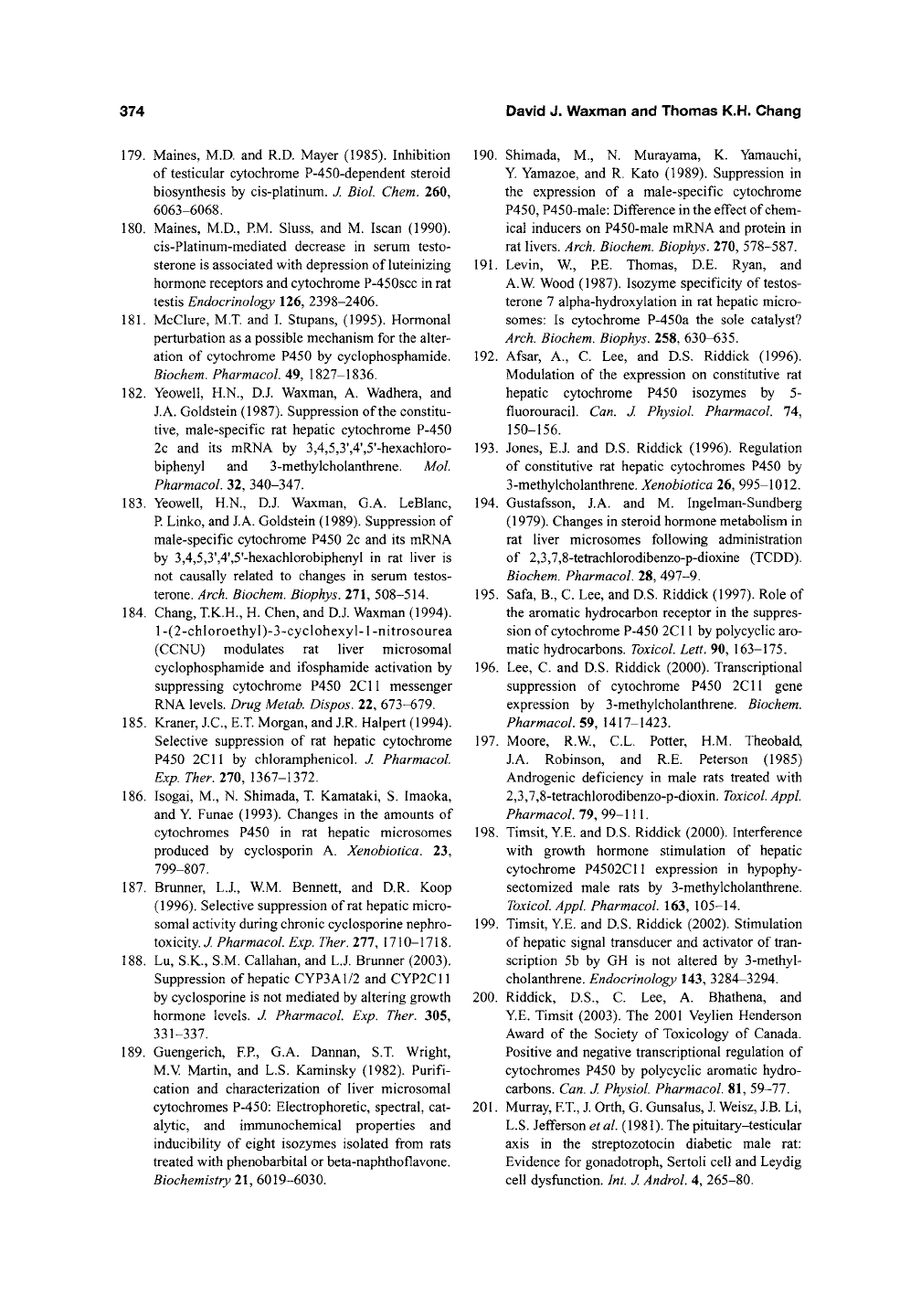
374
David J. Waxman and Thomas K.H. Chang
179.
Maines, M.D. and R.D. Mayer (1985). Inhibition
of testicular cytochrome P-450-dependent steroid
biosynthesis by cis-platinum. J. Biol. Chem. 260,
6063-6068.
180.
Maines, M.D., P.M. Sluss, and M. Iscan (1990).
cis-Platinum-mediated decrease in serum testo-
sterone is associated with depression of luteinizing
hormone receptors and cytochrome P-450scc in rat
testis Endocrinology 126, 2398-2406.
181.
McClure, M.T. and I. Stupans, (1995). Hormonal
perturbation as a possible mechanism for the alter-
ation of cytochrome P450 by cyclophosphamide.
Biochem. Pharmacol. 49, 1827-1836.
182.
Yeowell, H.N., D.J. Waxman, A. Wadhera, and
J. A. Goldstein (1987). Suppression of the constitu-
tive,
male-specific rat hepatic cytochrome P-450
2c and its mRNA by 3,4,5,3',4',5'-hexachloro-
biphenyl and 3-methylcholanthrene. Mol.
Pharmacol. 32, 340-347.
183.
Yeowell, H.N., D.J. Waxman, G.A. LeBlanc,
P.
Linko, and J.A. Goldstein (1989). Suppression of
male-specific cytochrome P450 2c and its mRNA
by 3,4,5,3',4',5'-hexachlorobiphenyl in rat liver is
not causally related to changes in serum testos-
terone. Arch. Biochem. Biophys. 271, 508-514.
184.
Chang, T.K.H., H. Chen, and D.J. Waxman (1994).
1
-(2-chloroethyl)-3-cyclohexyl-1 -nitrosourea
(CCNU) modulates rat liver microsomal
cyclophosphamide and ifosphamide activation by
suppressing cytochrome P450 2C11 messenger
RNA levels. Drug
Metab.
Dispos. 22, 673-679.
185.
Kraner, J.C, E.T. Morgan, and J.R. Halpert (1994).
Selective suppression of rat hepatic cytochrome
P450 2C11 by chloramphenicol. J. Pharmacol
Exp.
Ther. 210, 1367-1372.
186.
Isogai, M., N. Shimada, T. Kamataki, S. Imaoka,
and Y. Funae (1993). Changes in the amounts of
cytochromes P450 in rat hepatic microsomes
produced by cyclosporin A. Xenobiotica. 23,
799-807.
187.
Brunner, L.J., WM. Bennett, and DR. Koop
(1996).
Selective suppression of rat hepatic micro-
somal activity during chronic cyclosporine nephro-
toxicity
J.
Pharmacol. Exp. Ther. 211, 1710-1718.
188.
Lu, S.K., S.M. Callahan, and L.J. Brunner (2003).
Suppression of hepatic CYP3A1/2 and CYP2C11
by cyclosporine is not mediated by akering growth
hormone levels. J. Pharmacol. Exp. Ther. 305,
331-337.
189.
Guengerich, F.P, G.A. Dannan, S.T. Wright,
M.V Martin, and L.S. Kaminsky (1982). Purifi-
cation and characterization of liver microsomal
cytochromes P-450: Electrophoretic, spectral, cat-
alytic, and immunochemical properties and
inducibility of eight isozymes isolated from rats
treated with phenobarbital or beta-naphthoflavone.
Biochemistry 21, 6019-6030.
190.
Shimada, M., N. Murayama, K. Yamauchi,
Y Yamazoe, and R. Kato (1989). Suppression in
the expression of a male-specific cytochrome
P450,
P450-male: Difference in the effect of chem-
ical inducers on P450-male mRNA and protein in
rat livers. Arch. Biochem. Biophys. 270, 578-587.
191.
Levin, W, PE. Thomas, D.E. Ryan, and
A.W Wood (1987). Isozyme specificity of testos-
terone 7 alpha-hydroxylation in rat hepatic micro-
somes: Is cytochrome P-450a the sole catalyst?
Arch.
Biochem. Biophys. 258, 630-635.
192.
Afsar, A., C. Lee, and D.S. Riddick (1996).
Modulation of the expression on constitutive rat
hepatic cytochrome P450 isozymes by 5-
fluorouracil.
Can.
J. Physiol. Pharmacol. 74,
150-156.
193.
Jones, E.J. and D.S. Riddick (1996). Regulation
of constitutive rat hepatic cytochromes P450 by
3-methylcholanthrene. Xenobiotica 26, 995-1012.
194.
Gustafsson, J.A. and M. Ingelman-Sundberg
(1979).
Changes in steroid hormone metabolism in
rat liver microsomes following administration
of 2,3,7,8-tetrachlorodibenzo-p-dioxine (TCDD).
Biochem. Pharmacol. 28, 497-9.
195.
Safa, B., C. Lee, and D.S. Riddick (1997). Role of
the aromatic hydrocarbon receptor in the suppres-
sion of cytochrome P-450 2C11 by polycyclic aro-
matic hydrocarbons.
Toxicol.
Lett. 90, 163-175.
196.
Lee, C. and D.S. Riddick (2000). Transcriptional
suppression of cytochrome P450 2C11 gene
expression by 3-methylcholanthrene. Biochem.
Pharmacol. S9, 1417-1423.
197.
Moore, R.W, C.L. Potter, H.M. Theobald,
J. A. Robinson, and R.E. Peterson (1985)
Androgenic deficiency in male rats treated with
2,3,7,8-tetrachlorodibenzo-p-dioxin.
Toxicol.
Appl.
Pharmacol. 19, 99-\\\.
198.
Timsit, YE. and D.S. Riddick (2000). Interference
with growth hormone stimulation of hepatic
cytochrome P4502C11 expression in hypophy-
sectomized male rats by 3-methylcholanthrene.
Toxicol.
Appl. Pharmacol. 163, 105-14.
199.
Timsit, YE. and D.S. Riddick (2002). Stimulation
of hepatic signal transducer and activator of tran-
scription 5b by GH is not altered by 3-methyl-
cholanthrene. Endocrinology 143, 3284-3294.
200.
Riddick, D.S., C. Lee, A. Bhathena, and
YE.
Timsit (2003). The 2001 Veylien Henderson
Award of the Society of Toxicology of Canada.
Positive and negative transcriptional regulation of
cytochromes P450 by polycyclic aromatic hydro-
carbons. Can. J. Physiol. Pharmacol. 81, 59-77.
201.
Murray, F.T., J. Orth, G. Gunsalus, J. Weisz, J.B. Li,
L.S.
Jefferson et
al.
(1981). The pituitary-testicular
axis in the streptozotocin diabetic male rat:
Evidence for gonadotroph, Sertoli cell and Leydig
cell dysfunction. Int.
J.
Androl. 4, 265-80.
